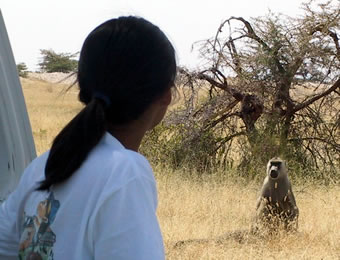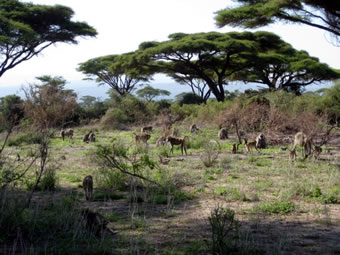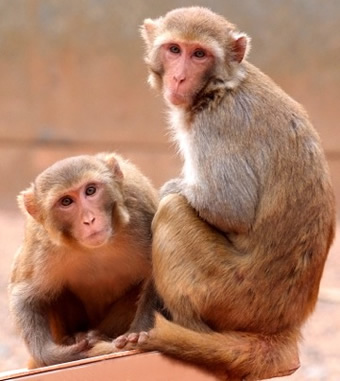
"Monkeys don't smoke, and they don't do yoga," says Jenny Tung. But monkeys do experience the kind of psychosocial stress that can drive humans to embrace both of those coping mechanisms. That's why Tung, an Assistant Professor of Evolutionary Anthropology and DuPRI Faculty Associate, believes monkeys are especially useful for shedding light on the ways that persistent stress can undermine human health.

Jenny Tung observing a baboon in Amboseli National Park, Kenya (courtesy Susan Alberts).
In captivity, the rhesus macaques Tung is studying don't have to worry about predators, but they're all the more exposed to the constant harassment of higher-ranking individuals, who have all the power and never let subordinates forget it. For low-ranking animals, the inescapable bullying and lack of control exert the sort of chronic stress shown in the famous Whitehall Study of British civil servants to lead to an early death.
The fact that low status, whether at work or in society in general, greatly raises a human being's chances for heart disease, stroke and a range of other illnesses is well documented but still poorly understood. So Tung is embarking on a five-year study to try to get at some of the underlying mechanisms of those health effects. With a $2.8 million grant from the National Institute of General Medical Sciences, Tung and her collaborators will create new social groups of female macaques at the Yerkes National Primate Research Center in Atlanta, manipulate the animals' social hierarchy and use a range of molecular techniques to profile their gene activity and immune responses.
SIGNATURES OF STRESS
In a preliminary project while she was a postdoctoral fellow at the University of Chicago, Tung found significant differences in gene regulation in the immune cells of female macaques depending on their social status—patterns so consistent that an individual's rank could be predicted with 80 percent accuracy based on her gene-expression profile alone. The results of that study, published in April, illustrate how stress-related hormones may signal immune cells to ready themselves for conflict, which the cells would do by raising or lowering the activity of certain genes. In the blood cells Tung examined, the biggest activity changes seen were in genes involved in inflammation and T-cell activation. Those processes help to fight infection, but are also implicated in heart disease and many other degenerative conditions.

Baboons in Amboseli National Park, Kenya.
The study also identified a possible mechanism for the gene-activity changes themselves. Methylation, the sequence of chemical groups along the surface of a DNA strand, constitutes a second "epigenetic" code involved in regulating which genes are activated and when. Tung's team identified clear signatures of rank in methylation changes near DNA regions involved in regulating the immune-related genes. One of Tung's goals in the new project is to explore whether any of the methylation changes associated with stress are long-lasting. There's already evidence that early-life stress can leave a permanent, even heritable, mark on DNA methylation. Noah Snyder-Mackler, a postdoc in Tung's lab who is currently looking at whether published signatures of social stress recapitulate those of aging, will examine the same question for the methylation changes associated with rank in macaques.
"We, like a lot of investigators at DuPRI who come from different directions, are interested in life history, health over the life course," says Tung. "Which is for [non-human primates] 'fitness'… Survival and health and reproduction are really where the rubber meets the road as far as fitness, and how social interactions affect differences in how individuals age over the life course, and how stress accumulates to influence those kinds of outcomes." Tung adds that she sees a lot of potential for cross-disciplinary work in genomics and aging. "We actually have a lot of shared questions, we just come at it from different angles."
A cross-species perspective was central during Tung's postdoc in Yoav Gilad's laboratory at the University of Chicago. Gilad, who is in the Department of Human Genetics, focuses on comparing primate genomes to understand gene-regulatory mechanisms and evolution. And, according to Tung, being around so many people doing human genetics work inspired ideas for getting the most out of the preliminary macaque study, many of which will carry over into the new project. In addition to looking at DNA methylation, the team examined the composition of immune cells in the monkeys' blood, to see whether certain types of cells were increasing or decreasing in response to stress. That also let them account for the possibility that apparent gene activity changes in a given cell type were the result of there being more of that type of cell present. In the new study, Tung and her colleagues will be measuring gene expression through RNA sequencing, which will let them look not just at the level of activity by a particular gene, but also whether its RNA is being "spliced" in alternative versions under different stress conditions.
Finally, Tung and her collaborators want to see how all these gene-activity changes might translate into a direct effect on health by challenging the monkeys' immune systems. Rather than exposing the animals to pathogens, though, the team will draw blood from the 10 highest-ranking and 10 lowest-ranking macaques directly into test tubes laced with antigens that immune cells recognize as parts of viruses or bacteria. This will allow them to capture the sets of genes that respond to a challenge, the magnitude of the response and identify which aspects of immunity (innate, adaptive, etc.) are influenced by dominance-rank effects.
GENE-BEHAVIOR DIALOGUE
Tung completed her Ph.D. in Biology at Duke in 2010, under the direction of Gregory Wray and Susan Alberts, and she hopes to continue work she started as a graduate student investigating subtle changes among wild baboons in Kenya's Amboseli National Park. The original population of yellow baboons there is now intermingled with a different subspecies, and Tung, who just returned from Kenya in July, is interested in how that admixture and hybridization affects maturation and mating behavior in the group. The baboon studies with Alberts "focus on longitudinal work, mostly observational, but also genetics," Tung says, "so the data are behavioral and social and demographic, with similarities to the types of data that some of the investigators at DUPRI collect" on people. With non-human primates, though, it's easier to eliminate some of the "noise," she explains.

Rhesus macaques at Yerkes, copyright Yerkes National Primate Research Center.
"One of the problems with humans is to demonstrate causality. Is the gene expression coming first or the social environment coming first?" Tung says. "We want what we're doing to be relevant to humans, so it's really helpful to do the parallel studies in humans, but doing them in macaques first establishes that social environment seems to have an effect as best we can assess." The social environment for a rhesus macaque is complex but a lot simpler than it is for humans. Especially in modern society, people are "interfacing with a lot of different individuals, depending on the day or time of day or context," according to Tung. So a person might be high-status at work, but berated at home, making it hard to characterize the influence of social status. "The other thing we can do with nonhuman primates is watch them all the time," Tung notes.In the new experiment, Snyder-Mackler is also interested in seeing whether the low-ranking monkeys adopt any behavioral patterns to help them cope with stress. "Social support is relevant for nonhuman primates, and some of the work my colleagues have done on baboons, for instance, has suggested that survival probabilities are affected by the strength of social bonds," Tung says. "That's mediated by grooming and proximity, also if someone is stressing you out, you should probably get away from them." The macaques at Yerkes will be divided into 10 social groups of five animals each, so it might be hard for an individual to avoid harassment from another of higher rank. For that reason, Tung thinks the investigators might get "a particularly clear signal" of social stress. "In a naturally constituted group, you might have more kin support to help offset that kind of harassment, just by being there or forming coalitions to dissuade that kind of behavior," she says.
If there's a theme to the Tung lab's work, it is adaptation - genetic and behavioral - to changing circumstances. "All of us are interested in the relationship between behavior and social structure and social structure and genes and the genome, and we pursue it in a lot of different ways," Tung says. "I have always worked on primate genetics in the context of evolution, so it's a natural fit. It's the sort of research that bridges between biology and evolution and aspects of behavior and genetics and evolutionary anthropology, so it doesn't seem like a stretch."
Jenny Tung, Ph.D., is Assistant Professor of Evolutionary Anthropology and a DUPRI Faculty Associate.